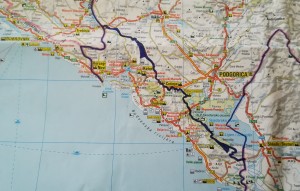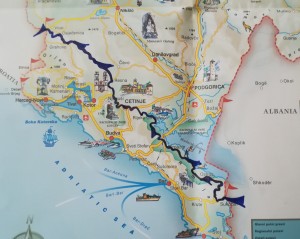(English version below)
Un cop caminades Tailàndia, Birmània, Bangladesh, Índia, Pamir, Tadjikistan, Uzbekistan, Iran, Azerbaidjan, Geòrgia, Turquia, Grècia, Macedònia, Albània i Montenegro amb aproximadament uns 13.100 quilòmetres als peus, ara entrem a Bòsnia-Hercegovina.
****
Slowly and steadily, we keep moving through the Balkans. For the next few weeks, we’ll be in Bosnia and Herzegovina, moving in parallel to the Croatian border.
With Macedonia, Albania and Montengero finished, our walking tally through Asia and Europe reaches about 13,100 kilometers walked. (Disclaimer – Jenn’s total is about 2,000 less than Lluís’ because of her non-walking weeks in India post-surgery and the different route she took in Turkey).
(Catalan version)
Després de Tailàndia caminàvem Birmània per encabat saltar a Àsia central per poder caminar Pamir, Tadjikistan i Uzbekistan evitant el seu cru hivern, així com també l’asfixiant monsó a Bangladesh i Índia. A continuació vàrem reprendre la ruta a Bangladesh, un pèl massa aviat per que les primeres setmanes ens ofegàvem de calor, humitat i en alguna que altra tempesta de final de monsó. Entrar a Índia per passar tot l’hivern ens va regalar perfectes temperatures diürnes, però poques hores de llum amb fredes nits i matinades on la boira espessa ens va acabar de congelar. L’operació quirúrgica de Jenn va marcar una important fita durant l’estada a Índia. Des de maig a juliol vàrem caminar Iran per creuar Azerbaidjan durant un agost severament calorós que ens va causar forces problemes, però després vàrem gaudir d’un molt bon setembre a través de les muntanyes, valls i rius del sud de Geòrgia. A continuació vàrem estar molt de temps creuant la llarga Turquia resseguint el mar Negre per després passar al mar de Marmara. Recentment hem creuat una part del nord de Grècia, bressol de la nostra civilització i hem campat per les muntanyes i llacs de Macedònia, Albània i Montenegro. Ara entrem a Bòsnia-Hercegovina per on estarem previsiblement enfeinats caminant per l’interior, en paral·lel a la frontera amb Croàcia.
Mirarem de seguir publicant i informant tan sovint com ens sigui possible, però com sempre, si no podem comunicar-nos, actualitzar o publicar molt freqüentment, assumiu que estem feliçment caminant entre bones persones i sobretot, que estem bé (o molt bé).
Així doncs, faré / farem el que bonament podrem, sense oblidar-nos de tots vosaltres que molt amablement ens seguiu, us interesseu per nosaltres, ens recolzeu i doneu ànims per continuar i als que us estem MOLT agraïts.






****
(English version)
Our Balkan stretch keeps surprising us, both in good ways and in challenging ways. And, our last two countries, Albania and Montenegro, had a mix of both.
Hospitality and kindness are the two words that followed us into the Albanian mountains. Although Albanians have a bad reputation among their neighbors and further abroad in Europe, we were showered with all sorts of goodness.
Nearly every day of our 11-day, ~200-kilometer walk in Albania, we were given water, offered coffee, invited to meals or given a free place to sleep inside a family’s home. We played with the kids, ran laps around a corn field with teenagers, watched a grandpa make homemade rakija (a 40 or more proof alcohol common in the Balkans), herded goats, picked tomatoes from the garden and spent time talking to many people about the state of life in the post-communist Albania and their future hopes.
In quick time, Albanians rose to third place on our informal hospitality ranking, falling behind the Iranians and the Pamiris (who we will think will be impossible to remove from the top two slots) and landing slightly ahead of the Greeks and Turks. Their friendship and help (especially during the many afternoon thunderstorms we faced) made our walk easier, the summer heat more tolerable and the views of mountains and rivers sweeter.
The words we have for the part of Montenegro we walked and the few people we encountered are isolated, distant and transitional. Our opinion may well be tainted by the fact that our 10-day, 160-kilometer walk on a inland, south-center route happened in blistering 35+ Celsius-degree heat during peak tourist season in August when most people flock to Montenegro’s seaside, but our feelings remain more negative than positive about this country.
We walked many small, scenic roads with very little traffic — something we often consider a positive, especially after the chaos we survived in India and Bangladesh many months ago. And, we had the unique pleasure of walking through an ancient chestnut forest where we camped among several hundred-year-old giants, one of our favorite nature moments during this leg of our foot journey. However, the severe lack of water and the suspicious faces of the people we did meet desperate to sell their homemade wine, rakija and honey made us reciprocate their unfriendliness, at least during the first week of our tour.
One afternoon, for instance, after a 20-22-kilometer stretch without shade along touristic Lake Skadar and finding only one well with water filled with algae and mosquito larvae, we came upon a makeshift roadside kiosk where an elderly couple was selling wine and juice. We asked them for a little bit of water. The woman quickly dismissed our request, saying she had none. Instead, she said we could buy a liter of some sort of pine fruit juice for 5 euros. When I gawked at the price, the husband cringed his face and waved me off; the wife pinched her lips, “We are pensionsers, have small money.” With thirst overtaking my sensibilities, I agreed to give her 3 euros for the juice, which ended up causing me a bad asthma-like wheezing allergic reaction. That same evening, when the daily shower passed through, I put my cooking pot and drinking cup under the leaky parts of an old school’s drain pipe and collected 650 ml of water, my only water source for the day.
Our last couple days in Montenegro were better. We met a few nice people who gave us water, coffee and let us camp in their garden or in the back of their cafe. These were invitations we sort of forced when our need for water and rain-proof shelter surpassed our desire to move discretely through the world and did not come willingly from the from the people who watched us walk by.
Though we are cynical about Montenegro specifically and the world and the human condition in general based on the undesirable behaviors we see on a regular basis (like the way people toss trash out of their car windows in nearly every country we pass through), all of this is to say that we expect nothing from anyone, and we know full well that no one has to do anything for us. We have chosen this walk, and it’s our responsibility to carry enough food and water and to find a safe place to sleep each night. But, this walk has presented us with an interesting sociology project. We are consciously and unconsciously studying which groups of people joyfully engage with us, who hesitates to lend a hand and what past and present political, economic and social circumstances may influence their interactions with strangers literally walking into their lives. Maybe one day we’ll write more on that.
For now, though, our focus stays on moving ahead into Bosnia and Herzegovina. We expect to walk another inland route about 450-500 kilometers, and avoid the August tourists moving up and down the Adriatic coast.
As always, we have no idea what our connectivity will be like or how soon we’ll be back online. Crossing borders means getting new money, new SIM cards and figuring things out in another language we don’t speak (well, at least in the Balkans, we have a working knowledge of Croatia language and that is helping a lot).
But, check back here now and again. We have new blogs scheduled in the next few weeks. And, we are posting on Instagram and Facebook as we can. Our tag on both pages is @bangkokbarcelonaonfoot. The links are below:
https://www.instagram.com/bangkokbarcelonaonfoot/
https://www.facebook.com/bangkokbarcelonaonfoot/
Thanks for walking with us!







